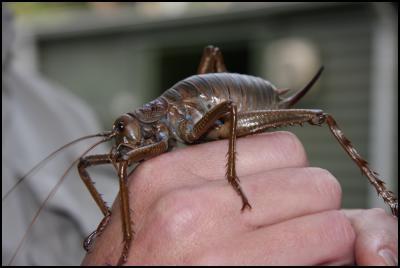Zoo’s own wētā workshop produces rare giants for release
Zoo’s own wētā workshop produces rare giants for release

wētā punga
Following
unprecedented breeding and rearing success, Auckland Zoo is
today releasing 150 of New Zealand’s largest giant wētā,
the wētā punga, onto pest-free Motuora Island in the
Hauraki Gulf.
A further 150 of these ‘Nationally Endangered’ invertebrate heavyweights (one of the world’s heaviest insects that can weigh as much as a sparrow) will be released onto Tiritiri Matangi next month. Another 200 are scheduled to be released to the wild later in the year, and a group of adults will also remain at the Zoo to help breed a second generation for future releases.
All offspring have been bred from six male and six female wētā punga, translocated to the Zoo in May 2012 from Little Barrier (Hauturu o Toi) - the only place they are now naturally found, as part of the Department of Conservation’s (DOC)wētā punga breeding recovery programme.
Auckland Zoo’s curator of ectotherms and birds, Richard Gibson, says for the first time, new techniques involving rearing the insects in groups as well as individually, were trialed within the Zoo’s temperature controlled weta facility.
“Because we were hatching so many, we established groups of anywhere from five up to 100 animals, in different sized enclosures. Within these we also created ‘wētā punga apartment blocks’ from bamboo and hosepipe to give individuals the necessary hiding places. In addition, we had to ensure adequate height and hanging places for the weta to moult successfully – which they do 10 times to reach adulthood,” says Mr Gibson.
“It’s been a
pretty intense period of work for the team, but an absolute
privilege to be helping such an iconic threatened species.
We’re delighted to have achieved a 95% success rate in
rearing animals individually, and around 50% success rate
with the groups - significantly higher than we expected.
The purpose of any captive rearing for release like this is
to ensure a high survival rate in the wild. The 150 wētā
punga we’re releasing today are close to adulthood and not
far off producing babies of their own, which is great, and
because of their age and size have an optimum chance of
survival.”
DOC scientific advisor, Chris Green,
explains this is part of the wētā recovery group’s plan
to establish several populations around the gulf, ensuring
the survival of the species and their long term
security.
“By using captive breeding we can now
transfer several pioneer populations to other islands,
improving the chances of the species surviving in the event
of a catastrophe on Little Barrier wiping them out for
ever,” says Dr Green.
Along with other iwi, Ngati
Manuhiri, the guardians of the wētā punga, are fully
supportive of this programme and will be represented at the
release.
Besides its off-display breeding population, a number of wētā punga are also on public display in the night area of the Zoo’s Te Wao Nui precinct.
ENDS
Wētā punga Fast Facts
• The wētā punga dates back more than 190
million years. Once widespread throughout Auckland,
Northland and Great Barrier Islands, due to mammalian
predators, it has only survived on Little Barrier Island
(Hauturu o Toi)
• The largest of New
Zealand’s 11 giant wētā species and one of the
world’s heaviest insects. Females are heavier than males
and can weigh up to 35 grams, heavier than an average house
sparrow. Largest ever recorded was a female weighing 71
grams!
• An adult by 18 – 24 months, wētā
punga start breeding soon after this. Females lay between
100 – 300 eggs throughout their life. Wētā punga live
for about nine months after reaching maturity
•
A wētā punga goes through 10 moultings to reach adulthood,
and will eat each exoskeleton that it sheds, as it provides
a great source of protein
• For its size, the
wētā punga produces one of the largest poo pellets of any
insect! Extremely valuable, since its poo helps greatly in
germinating and distributing plant seeds
• As
well as Auckland Zoo, Butterfly Creek is also involved in
DOC’s breeding recovery programme for wētā punga. In
2010 it released 25 wētā punga onto Motuora Island, and in
2011, a further 25 onto Tiritiri Matangi Island. An
additional 35 were released onto Motuora in 2012.
•
The wētā punga, a nocturnal species, is classified as
‘Nationally Endangered’
Motuora Island
•
Motuora Island is a recreational reserve, 5km off the coast
of the Mahurangi area south of Warkworth
• The
island is being restored by the Motuora Restoration Society
with 250,000 trees having been planted over the past 19
years. Translocations of skinks, geckos and birds have
already begun. The island is also a crèche for Northland
brown
kiwi.
Ends


 WorkSafe NZ: Overhead Power Lines Spark Safety Call
WorkSafe NZ: Overhead Power Lines Spark Safety Call Transpower: Transpower Seeks Feedback On Electricity Investment Short-list For Upper South Island
Transpower: Transpower Seeks Feedback On Electricity Investment Short-list For Upper South Island Commerce Commission: “Cheating The System” – Sentencing In Country’s First Criminal Cartel Case
Commerce Commission: “Cheating The System” – Sentencing In Country’s First Criminal Cartel Case Kiwi Economics: The Government’s Books Are Hard To Balance. Lower Productivity, Lower Tax, Higher Spend
Kiwi Economics: The Government’s Books Are Hard To Balance. Lower Productivity, Lower Tax, Higher Spend Watercare: Watercare’s $13.2 Million Solution To Lift Long-term No-swim Warning At Judges Bay
Watercare: Watercare’s $13.2 Million Solution To Lift Long-term No-swim Warning At Judges Bay FIRST Union: 'A Long Fight' - Woolworths Supermarket Workers Ratify New Wage Agreement
FIRST Union: 'A Long Fight' - Woolworths Supermarket Workers Ratify New Wage Agreement



